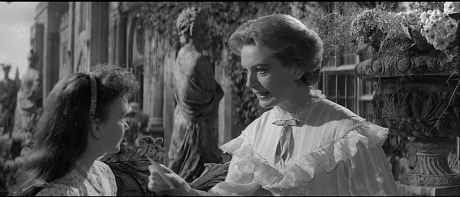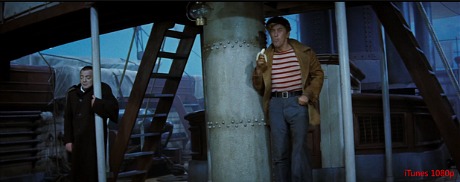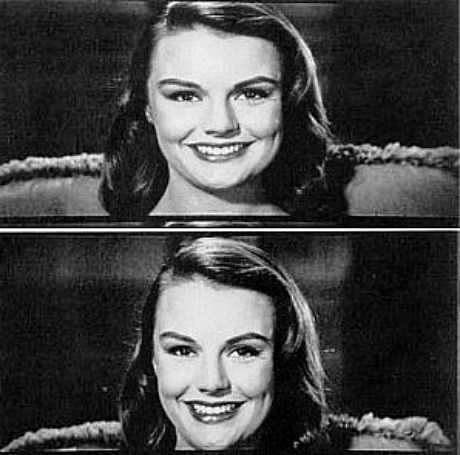For many years I’ve been lamenting the “CinemaScope mumps” distortion syndrome, or that face-broadening, weight-adding effect that resulted from the use of anamorphic CinemaScope lenses from ’53 through ’60. It would be heaven if someone could figure a way to horizontally compress these films so that the unnaturally widened effect would look right. Every mumped-up movie gives you a fundamental feeling of being cheated out of God’s natural proportions. I’m therefore interested in Criterion’s recently-announced Bluray of Jack Clayton‘s The Innocents (9.23.14), which has always been mumps-afflicted since its initial release in 1961 and has definitely looked this way on home video presentations.


And yet, as the Disney guys reportedly showed three years ago in their restoration of Richard Fleischer‘s 20,000 Leagues Under The Sea, fixing the “mumps” distortion is technologically achievable. A Criterion summary of the contents of the Innocents Bluray mentions a “new interview with cinematographer John Bailey on director of photography Freddie Francis and the look of the film,” but there’s no mention of any “mumps” correction. I’m presuming that a decision was made to keep the mumps, but maybe not.
I’ve e-mailed Criterion’s Peter Becker to verify one way or the other and to discuss the rationales for either approach. Here’s a portion of my letter:
“Three years ago the Disney guys reportedly de-mumpified 20,000 Leagues Under The Sea for a high-def restoration that appeared on iTunes (but not Bluray). They reportedly achieved this effect by horizontally squeezing the image by .5%.
“Here’s an excerpt from a Reel Thing report about the 20,000 Leagues restoration:
“‘20,000 Leagues Under The Sea was also one of the first films to be photographed in CinemaScope using first generation Bausch & Lomb anamorphic lenses. Unfortunately these lenses had an inherent distortion known today as ‘the CinemaScope Mumps’. CinemaScope Mumps occur due to the variable ‘squeeze’ coefficient throughout the focal plane. This causes the anamorphic effect to gradually drop off as objects approach closer to the lens. This results in images being slightly overstretched in the horizontal plane, most noticeably on actor close-ups.

Apparent screen capture from restored version of 20,000 Leagues Under The Sea.
“‘Using original on-set production and publicity photos for accurate sizing reference, the restoration team removed much of this distortion by digitally squeezing in the image .5%. Since the original camera negative of 20,000 Leagues was actually shot perf to perf in 2.66:1, this new restoration has gained 1.6mm of image on the left side and .25mm on the right side of the frame-all of which had heretofore been concealed by the mag track in original prints. This ‘mumps’ correction enabled us to faithfully reconstruct the original 2.55:1 image as seen in first-run theaters during the 1954 and early 1955 theatrical engagements.’
“If in fact Criterion has elected not to de-mumpify The Innocents for its forthcoming Bluray, the obvious question is why?
“If Criterion has in fact decided against de-mumpifying The Innocents (and I’m not at all certain that this is the case), does this mean that Criterion is more or less committed to replicating the CinemaScope mumps effect for posterity (ad infinitum, from here to eternity) with other CinemaScope films shot between ’53 and ’60?

Jack Hawkins all mumped up in The Bridge on the River Kwai.
“Criterion is renowned for its grain-monk theology. I’ve lost count of the number of Criterion-remastered classics that have struck me as overly or oppressively grainy. (Although I have to offer my heartfelt congratuations on the just-released Red River Bluray, which is EXTREMELY PLEASING for is lack of an obnoxious grainstorm effect, unlike the Masters of Cinema Bluray version that came out last last year.) But is there also a cabal of ‘mump monks‘ within Criterion?
“Obviously I sound like I’m joking about this, but this is an issue worth addressing, I think. Obviously the CinemasScope mumps distorted reality, and obviously the technology exists to correct this distortion. So what’s the argument in favor of keeping the mumps, if in fact that is Criterion’s position?
“I’m interested because in a private email yesterday a certain restoration authority mentioned a ‘moral’ issue in fixing the mumps syndrome on Bluray restorations. The gentleman in question is fine with issuing both a mumped-up and de-mumpfied version of films afflicted with this syndrome, but he also feels that correcting mumps distortion is some kind of dicey issue. I don’t agree (i.e., in my view fixing mumps isn’t substantially different than erasing the wires holding up the Martian spaceships in War of the Worlds and and the wires holding up the monkeys in The Wizard of Oz) but maybe this view is shared by others. Is it?”













